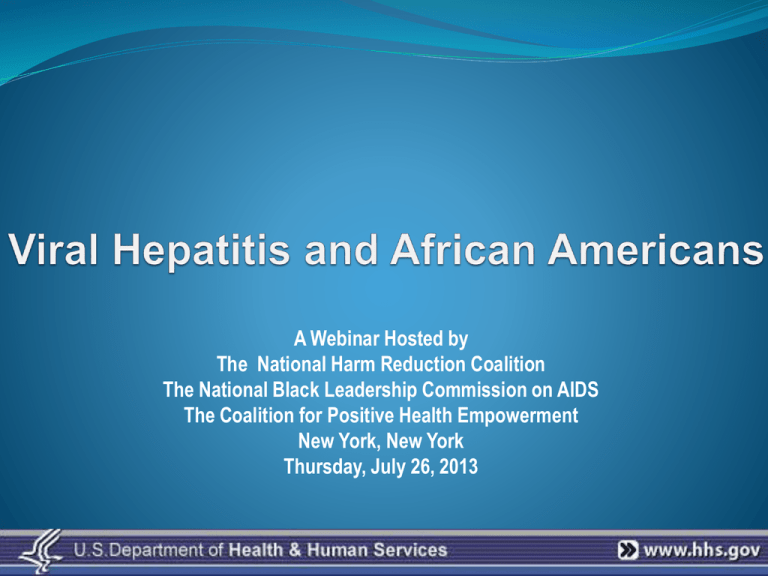
A Webinar Hosted by
The National Harm Reduction Coalition
The National Black Leadership Commission on AIDS
The Coalition for Positive Health Empowerment
New York, New York
Thursday, July 26, 2013
What is Viral Hepatitis?
“Hepatitis” means inflammation of the liver. Most often Hepatitis is
caused by a virus.
The most common types in the US are:
Hepatitis A
Hepatitis B
Hepatitis C
Viral hepatitis is the leading cause of liver cancer and a common
reason for liver transplantation.
How Common are Hepatitis B and C?
In the U.S., an estimated 40,000 new Hepatitis B infections
occur each year. About 1.4 million people are living with chronic
Hepatitis B, and many do not know they are infected.
An estimated 3.2 million people in the U.S. have Chronic
Hepatitis C.
More than 75% of adults with Hepatitis C are baby boomers.
Baby boomers are people born from 1945 through 1965.
Most of them don’t know they are infected.
Viral Hepatitis Epidemiology,
Hepatitis C
Chronic Hepatitis C in the Context
of HIV in the US
Incident cases: 17,000 (2010)
(annual)
Chronic: 3.2 Million
(prevalent cases)
Deaths: 15,000 (2010)
(annual)
Age-adjusted Rates of Mortality Associated for
Hepatitis B, Hepatitis C, and HIV
United States, 1999-2007
In 2007, > 70% of registered deaths in HCV-infected were aged 45-64 years old.
National Viral Hepatitis Action Plan United States, 2011-2013
1. Educating providers and communities to reduce
2.
3.
4.
5.
6.
health disparities
Strengthening surveillance to detect viral
hepatitis transmission and disease
Eliminating transmission of vaccine-preventable
viral hepatitis
Reducing viral hepatitis cases caused by druguse behaviors
Protecting patients and workers from healthcare-associated viral hepatitis
Improving testing, care, and treatment to prevent
liver disease and cancer
Proposed 2020 Goals of the Viral
Hepatitis Action Plan (full implementation)
Increase from 33% to 66% the proportion of persons who are
aware of their HBV infection
Increase from 45% to 66% the proportion of persons who are
aware of their HCV infection
Reduce by 25% the number of new HCV infections
Eliminate mother-to-child HBV transmission
Growing Momentum to Address
Viral Hepatitis
Aggressive promotion of perinatal vaccination for hepatitis B
Increasing efforts nationally to get “baby boomers” tested
Expansion of training and education opportunities for physicians
and clinical staff
Era of improved therapy for hepatitis C
Increasing support to address chronic viral hepatitis in the US &
globally
Why is Viral Hepatitis Testing
Important?
Many people with chronic viral hepatitis do not know they are infected since they do
not look or feel sick.
Testing is the only way to determine whether or not a person has chronic hepatitis B
or C.
Learning if one is infected is key to diagnosing chronic viral hepatitis early and
getting appropriate medical care.
Testing can also identify at-risk household members and sexual partners who
should also be tested and/or vaccinated.
Over time, approximately 15%–25% of people with chronic viral hepatitis develop
serious liver problems, including:
o liver damage,
o cirrhosis,
o liver failure, and
o liver cancer.
Who Should Get Tested for
Hepatitis B?
Testing for Hepatitis B is recommended for certain groups of people, including:
People born in Asia, Africa, and other
regions with moderate or high rates of
Hepatitis B
Unvaccinated people whose parents
are from regions with high rates of
Hepatitis B
Anyone having sex with a person
infected with Hepatitis B
People who live with someone with
Hepatitis B
Men who have sexual encounters with
other men
People who inject drugs
All pregnant women
People with HIV infection
People on hemodialysis
People who receive chemotherapy or
other types of immunosuppressive
therapy
Hepatitis C in the African American
Community Information
http://www.cdc.gov/hepatitis/Populations/AAC-HepC.htm
Who Should Get Tested for
Hepatitis C
Current or former injection drug users, even if you injected only one time or many
years ago.
People treated for a blood clotting problem before 1987.
People who received a blood transfusion or organ transplant before July 1992.
People who are on long-term hemodialysis treatment.
Anyone who has abnormal liver tests or liver disease.
Health care or public safety workers exposed to blood through a needlestick or
other sharp object injury.
People who are infected with HIV.
Individuals born from 1945 through 1965
Online Resources For You and
Your Community
Hepatitis Risk Assessment
http://www.cdc.gov/hepatitis/
RiskAssessment/
CDC’s KNOW MORE HEPATITIS
Campaign
http://www.cdc.gov/knowmorehepatitis/
CampaignResources.htm
Additional Online Resources
Digital Tools - Buttons, Widgets, and more:
http://www.cdc.gov/hepatitis/HepPromoResources.htm
Order free posters & other resources:
http://wwwn.cdc.gov/pubs/hepa.aspx
Thank You!
Christopher H. Bates, MPA
Senior Advisor to the Director
Office of HIV/AIDS and Infectious Disease Policy
U.S. Department of health and Human Services
Christopher.bates@hhs.gov
(202) 205-5245






